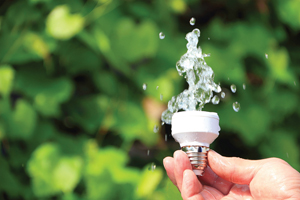Energy and water: an alliance of purpose
 There is an inherent connection between energy and water use and the need for co-management of energy planning. Most of the energy we use requires copious amounts of water to produce, and most of the water we use requires a considerable amount of energy to treat and transport.
There is an inherent connection between energy and water use and the need for co-management of energy planning. Most of the energy we use requires copious amounts of water to produce, and most of the water we use requires a considerable amount of energy to treat and transport.
Despite this inherent connection, it’s actually uncommon to see energy and water utilities collaborating to identify best practices to save energy and water and even lower costs. Think of it this way: If energy and water utilities worked together, their unique perspectives could uncover joint cost-saving solutions, customers would save more money and utilities could share data to better understand their holistic energy-water footprint.
Identifying why there is a lack of collaboration and how to overcome these barriers was the motivation behind the American Council for an Energy-Efficient Economy’s (ACEEE’s) recent report. The report goes bey ond citing d iscrepancies, though, and provides solutions for energy and water utilities to create better, more resource-efficient programs for themselves and their customers.
The report highlights a number of ways U.S. energy and water utilities have collaborated to identify mutually-beneficial energy and water savings. It lists successful energy and water utility programs from a variety of different sectors, including residential, commercial, industrial, agricultural and municipal.
One energy-water success story the report features comes from my own backyard, Austin, Texas. Traditionally, it’s difficult to incentivize energy and water savings in multifamily dwellings because residents only rent the property. While the resident pays the utility bill, the landlord is the one responsible for long-term efficiency improvements. To fix this split incentive, the City of Austin created the Multifamily Energy and Water Efficiency Program, which provides multifamily dwelling owners with holistic energy and water efficiency evaluations, rebates and other incentives to conserve both resources. The program is a collaboration of Austin Water Utility, Austin Energy and Texas Gas Service.
It’s important to note that without technology, these savings would not be realized. As the ACEEE report suggests, smart electric meters—devices that enable two-way communication to and from the utility and the customer—are lifting the veil, so to speak, by allowing utilities to understand how and when customers use energy and uncover opportunities for conservation. Smart water meters, on the other hand, are much less common than smart electric meters and the technology is not as advanced. But these smart water meters are key to unlocking holistic energy-water savings.
Pecan Street Inc., a smart grid living laboratory based in Austin, Texas, is one of the only smart grid demonstration projects in the country working to bridge this water information gap. By installing smart water meters on homes of willing participants, residents can access water usage data down to the hour-by-hour level, giving utilities clear oversight to detect leaks and even theft. The goal is to share important lessons learned with other utilities and municipalities and spur further innovation in the smart water meter sector. Of course, some utilities are already ahead of the curve.
In April of this year, the City of Davis in California launched a cloud-based, city-wide Water Conservation Program that provides its 14,000 residential customers with a dual billing and usage data platform. The technology provider, WaterSmart Software, also sends participants personalized Home Water Reports that display household water use, compare household usage to other similar-sized homes and suggest conservation tips.
By breaking down the silos between different utilities, the cities of Austin and Davis overcame many barriers that joint programs face and established programs that unlock all-inclusive energy-water savings. These success stories are just some of the examples documented in ACEEE’s report. It’s clear there are numerous opportunities for utilities to create more joint programs to help save both energy and water.
To increase collaboration, the report recommends:
- Begin a dialogue about opportunities between the two (or more) utilities and establishing relationships
- Create utility partnerships for joint messaging
- Collaborate to identify unique funding opportunities
- Develop a format to add energy savings to water programs and vice versa
- Work with energy regulators to establish credit for embedded energy savings from water efficiency programs
In the future, we hope utilities and regulators take the report’s recommendations under consideration to create more joint programs in Texas and beyond.

Author Kate Zerrenner leads the Environmental Defense Fund’s campaign to influence and enact state and national energy and water efficiency policy, including breaking down financial, regulatory and behavioral barriers.
The report mentioned within this article is the American Council for an Energy-Efficient Economy’s “Saving water and energy together: helping utilities build better probrams,” by Rachel Young, Oct. 2013, Report E13H
Historical perspective
- March 2024
- February 2023
- July 2022
- March 2022
- June 2021
- February 2021
- August 2020
- February 2020
- July 2019
- April 2019
- June 2018
- April 2018
- October 2017
- May 2017
- November 2016
- June 2016
- November 2015
- June 2015
- September 2014
- June 2014
- April 2014
- December 2013
- July 2013
- December 2012
- July 2012
- October 2011


